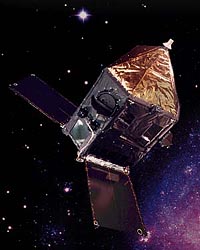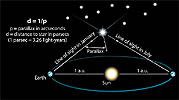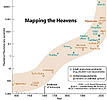| From Hipparchus to Hipparcos: Measuring the Universe, By Catherine Turon Adapted from Sky & Telescope |  Hipparcos Satellite, Courtesy ESA. |
| From Hipparchus to Hipparcos: Measuring the Universe, By Catherine Turon Adapted from Sky & Telescope |  Hipparcos Satellite, Courtesy ESA. |
HIPPARCHUS OF NICEA must have been an interesting fellow. He was a second-century B.C. mathematician, philosopher and astronomer. Using the only astronomical instrument available to him -- his eyes -- Hipparchus took on the daunting task of measuring the positions of the stars and planets as they passed overhead each night. He came up with a catalog of 1,080 stars, each of which he described simply as "bright" or "small."
Hipparchus wasn't the first astronomer to pursue the science of astrometry, as the astronomical discipline of positional measurement is now called. However, his star catalog was the first of many compiled over the centuries by astronomers using ever-better instruments and techniques. From those measurements -- all made from the Earth's surface -- astronomers have derived everything from basic stellar properties to estimates for the age of the universe.
On August 8, 1989, the science of astrometry took a long-awaited leap to the stars. Riding aboard an Ariane rocket was the High Precision Parallax Collecting Satellite, otherwise known as Hipparcos. For the next three and a half years, Hipparchus's 20th-century namesake measured the parallaxes and brightnesses of more than a million stars -- despite a potentially crippling accident that sorely challenged the project's architects.
To measure such shifts, the satellite was built to scan the sky continuously. A beam combiner would allow two sight lines, separated by 58
Hipparcos's first-priority targets, 118,000 in number, were selected by more than 200 scientists working to determine a plethora of astronomical fundamentals: distances, motions, luminosities, masses, sizes, and ages for a wide range of red and white dwarfs, giant stars, radio and X-ray stars, variables, and binary stars. In addition, studies of star-cluster dynamics, stellar physics, and the interstellar medium were planned. Finally, the project would seek to establish a fundamental reference frame for the sky's visible stars and to connect that grid with objects seen in other portions of the electromagnetic spectrum.
In parallel with these space-based observations, ground-based programs were organized in cooperation with professional and amateur observers to obtain good positional and photometric data for selected program stars. This would allow mission planners to optimize their use of the satellite's limited lifetime. Major collaborative projects also began between users of the Hubble Space Telescope, very long baseline radio astronomers, and other important ground-based programs.
Excitement in the Hipparcos community of researchers, some of whom had worked with the project for 20 years, was high as Ariane lofted its precious payload into the sky. Their enthusiasm turned to disappointment, however, when the spacecraft's apogee-boost motor failed to fire. This left Hipparcos in an elongated orbit that took it through the Van Allen belts, which posed the risk of serious radiation damage to the solar panels that powered the spacecraft (S&T May 1990, page 496).
Fortunately, those panels turned out to be more resistant to radiation than expected. Over the course of several months, the European Space Agency Project Team, the European Space Agency Operation Center (ESOC), members of industry, and the Hipparcos scientific consortia turned their collective attention to the observational and scheduling problems posed by the highly eccentric orbit. As a result of their heroic efforts, the mission ran successfully from November 1989 to March 1993, gathering data 60 percent of the time.
As it turns out, Hipparcos exceeded expectations, achieving accuracies at the one-milliarcsecond level for all its principal targets; in addition, high-precision photometric measurements of these stars' brightnesses were obtained.
The satellite's star mappers were also used to survey more than 1 million stars down to magnitude 11.5; accuracies of 0.01 arcsecond and 0.02 magnitude were acheived for stars brighter than magnitude 9.5. This part of the mission was called Tycho, after the prolific 16th-century Danish astronomer, Tycho Brahe.
The Hipparcos data are best grouped into three main areas: distances based on parallax measurements, brightnesses of variable stars, and positions within multiple-star systems. For distances, the Hipparcos data are providing a dramatic increase (both qualitatively and quantitatively) in the information for nearby stars. For example, before Hipparcos, astronomers had calculated distances to only a few dozen stars with 1 percent precision. Hipparcos has provided such measurements for more than 400 stars. At the 5 percent level, ground-based astrometry had triangulated only 100 or so stars. Hipparcos has measured more than 7,000 stars with such precision. Accurate distance determinations are now available within some 500 light-years of the Sun.
This dramatic improvement in distance determination has opened a new and exciting era of reassessment in many astrophysical arenas, such as stellar structure and evolution; the structure, dynamics, and evolution of galaxies; and the cosmic distance scale, with its implications for the universe's size, history, and eventual fate.
The range of stellar spectral types and luminosity classes for which precise parallax measurements are available has also been expanded greatly by the Hipparcos measurements. This is true especially in the upper part of the main sequence, whose young, bright stars are relatively rare, and toward the giant branch of the Hertzsprung-Russell diagram -- home to the senior citizens in stellar astronomy's family tree.
Nearly 12,000 entries in the Hipparcos Catalogue proved to be variable or possibly so; 8,200 of them were not known before the mission. (An entry can be a single star, one component of a multiple-star system, or the combined light of such a system.) Among the 2,700 periodic variables discerned by Hipparcos, there are 273 Cepheids (2 of them new); 186 RR Lyraes (9 new); 108 Delta Scuti and SX Phoenicis types (35 new); 917 eclipsing binaries (343 new); and 1,238 others.
Parallaxes were obtained for several types of pulsating variables, and data from 20 Cepheids will be used to reexamine the basic assumptions behind the period-luminosity relation for these celestial yardsticks. Indeed, early results have already gone a long way toward resolving one of cosmology's central paradoxes -- the impression that globular clusters are older than the universe as a whole. In addition, our understanding of cluster membership will be greatly improved, and it should be possible to reassess the effect of colors and heavy-element content, or metallicity, on the period-luminosity relation.
Many fundamental results are expected from the Hipparcos observations of these stellar assemblages. The relationship between a star's mass and its luminosity will be probed, and stronger constraints will be brought to bear on evolutionary models for pairs of closely interacting stars.
Stars in open clusters were carefully selected for Hipparcos observations as well. Some of the closest and most familiar clusters were nicely sampled. In the Hyades, 210 stars were observed; in Coma Berenices, 120; in the Pleiades, 80; and in the Alpha Persei association, 130 stars. In addition to detailed studies of these very nearby clusters, Hipparcos observations allow distance determinations with better than 10 percent precision for about 10 clusters spanning a range of ages and metallicities.
What astronomers will do with those measurements goes far beyond the simple accounting of distances and brightnesses. There is no doubt that the improved parallaxes from Hipparcos and elsewhere will breathe new life into the discipline that Hipparchus set out to master so long ago (see "Mining the Hipparcos Mission's Treasures"). And by painstakingly sifting the light from so many stars, Hipparcos has given astronomers a vital new tool to expand our understanding of the universe.
Catherine Turon, a member of the Hipparcos Science Team, is an astronomer at Paris Observatory, France.
HIPPARCOS'S SUCCESSFUL HARVEST
Hipparcos Targets: 118,000 stars Magnitude limit: 12.5 Astrometric resolution: 0.001 arcsecond Photometric resolution: 0.002 magnitude Tycho Targets: 1 million stars Magnitude limit: 11.5 Astrometric resolution: 0.025 arcsecond Photometric resolution: 0.06 magnitude One arcsecond is 1/3,600 of 1° and is the typical resolution
of ordinary ground-based visible-light telescopes.
One magnitude corresponds to a 2.5-fold change in bright-
ness. For historical reasons, smaller magnitude numbers
indicate brighter stars. (27K JPEG) Finding a star's distance from its parallax. Every six months, the Earth moves nearly 186 million miles from one side of its orbit to the other. This is enough to give us slightly different lines of sight to a nearby star seen against distant stars in the far background. The "parallax shift" is extremely tiny -- less than an arcsecond -- but Hipparcos has measured it with state-of-the-art precision for one million stars.
(27K JPEG) Finding a star's distance from its parallax. Every six months, the Earth moves nearly 186 million miles from one side of its orbit to the other. This is enough to give us slightly different lines of sight to a nearby star seen against distant stars in the far background. The "parallax shift" is extremely tiny -- less than an arcsecond -- but Hipparcos has measured it with state-of-the-art precision for one million stars.
 (31K JPEG)/(40K JPEG) By far the best Hertzsprung-Russell diagram ever compiled. This stellar family tree, a graph of stars' colors and luminosities, includes the 20,853 stars whose distances and colors Hipparcos measured with better than 10 and 25 percent accuracy, respectively. Courtesy Michael Perryman, from a paper submitted to Astronomy & Astrophysics.
(31K JPEG)/(40K JPEG) By far the best Hertzsprung-Russell diagram ever compiled. This stellar family tree, a graph of stars' colors and luminosities, includes the 20,853 stars whose distances and colors Hipparcos measured with better than 10 and 25 percent accuracy, respectively. Courtesy Michael Perryman, from a paper submitted to Astronomy & Astrophysics.
TRACKING STELLAR VARIABLES
MASTERING MULTIPLE-STAR SYSTEMS
BEYOND HIPPARCOS
 (33K JPEG)/(45K JPEG) A brief history of astrometry. Positional measurements have improved nearly 100,000 times since Hipparchus eyeballed the sky's brightest 1,000 stars shortly before the birth of Christ.
(33K JPEG)/(45K JPEG) A brief history of astrometry. Positional measurements have improved nearly 100,000 times since Hipparchus eyeballed the sky's brightest 1,000 stars shortly before the birth of Christ.
This material may not be reproduced in any form without permission.
For more information contact Sky Publishing Corp., P.O. Box 9111, Belmont, MA 02178-9111, USA. Phone: +1-617-864-7360. Fax: +1-617-576-0336 (editorial only), +1-617-864-6117 (all other).